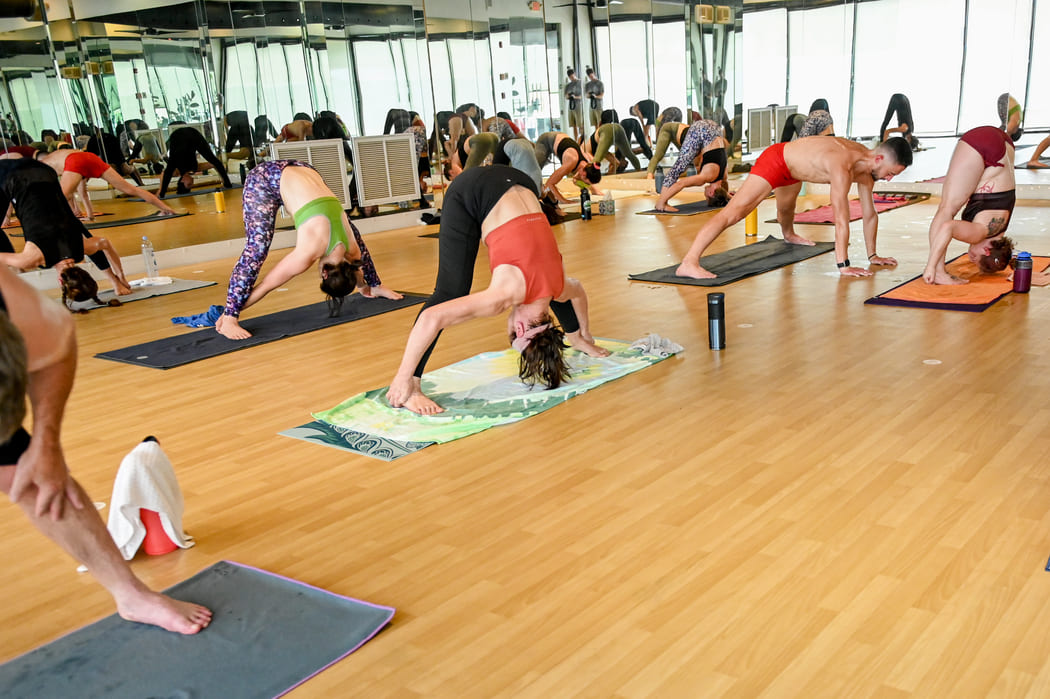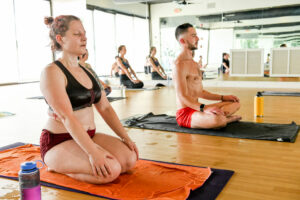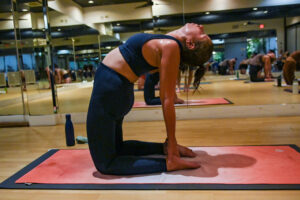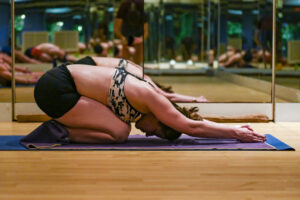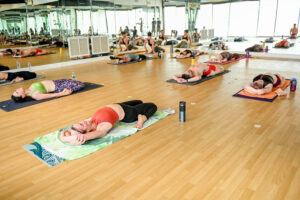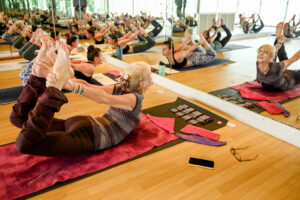If you got a chance to read our previous article on the camel pose, then you already know that it’s one of the more challenging Bikram yoga poses. Now I’m here to show you the polar opposite of the camel pose – the rabbit pose (Sasankasana).
But why is it so different?
While the Rabbit Pose emphasizes forward flexion and exhaling, the camel pose involves backward extension and inhaling, symbolizing a deep breath of fresh air. These two yoga poses are not only physically contrasting but also evoke opposite emotional energies. They represent the yin and yang within yoga, giving yogis a balance of introspection and openness.
They’re a pair of poses that, although diametrically opposed, complement each other well for the diverse range of physical sensations and mental stimulation they offer.
And with that out of the way, let’s hop to it!
Before diving into the Rabbit Pose, here is what we will cover in this article:
Unearthing the Story of the Rabbit Pose
Every yoga pose has a rich history, often rooted in ancient traditions and symbolism. And the Sasankasana, also known as the Rabbit Pose, is no exception.
This pose gets its name from two Sanskrit words: “sasanka,” meaning “rabbit,” and “asana,” meaning “pose.” The name itself conjures images of a rabbit burrowing into its hole. The pose is a testament to the yogic connection between animals and nature since yoga often draws inspiration from the world around us.
While the Rabbit Pose itself predates Bikram Yoga as a traditional yoga asana, its adaptation and incorporation into the Bikram Yoga series was a big deal.
It’s also worth noting that Bikram Choudhury’s approach to yoga bore most of its personality for its focus on practicing in a heated room, and this environment plays a crucial role in the benefits and challenges of the Rabbit Pose in the context of Bikram Yoga.
The exact way that the Rabbit Pose became part of Bikram Yoga may not be as hugely documented as the development of the entire Bikram Yoga series. However, what is clear is that the Rabbit Pose, as practiced in Bikram Yoga, is part of a structured sequence that aims to provide a comprehensive, physically demanding, and rewarding yoga practice.
It’s meant to challenge and transform both the body and the mind, fostering strength, flexibility, and mental focus.
How to Hop into Sasankasana – Rabbit Pose: Step-by-Step Guide
Now that we’ve explored a little bit of the roots of the rabbit pose, let’s get practical and break down how to perform this pose:
- Start in a comfortable seated position on your heels, taking in the atmosphere of your Bikram yoga class. If you’re transitioning out of the camel pose, make sure to give yourself a few moments to collect yourself. It can take a little bit of mental gymnastics to get your mind into the right place for what’s about to be a very different type of pose.
- With your hands resting on your heels, reach your arms forward.
- Begin to curl your chin to your chest and round your spine, moving your forehead towards your knees.
- Keep reaching forward, lengthening your spine as you exhale and compress your abdomen.
- Hold this pose for a few breaths, focusing on the gentle compression and elongation of your spine.
- Release the pose with care, and slowly uncurl your spine to return to a comfortable seated position.
- Remember, the key to Bikram yoga poses like Sasankasana is patience and gradual progression. Take your time and ease into the pose, and with regular practice, you’ll find your flexibility and comfort levels increasing.
Benefits of Doing the Rabbit Pose
Now, let’s talk about the bounty of benefits that come with practicing Sasankasana:
- Spinal Health: The rabbit pose offers an exquisite stretch to your spine, helping to maintain its flexibility and alignment. It’s like a mini-vacation for your vertebrae.
- Stress Reduction: As you curl into this pose, you create a calming pressure on your abdomen, which can help alleviate stress and anxiety. The act of folding inward mimics the comfort of a rabbit in its burrow.
- Digestive Boost: The gentle compression on your abdominal organs during Sasankasana can help improve digestion and alleviate any discomfort or bloating.
- Enhanced Focus: This pose encourages introspection and inner focus, which can help you find mental clarity and relaxation.
- Therapeutic for Respiratory Issues: The rabbit pose can help individuals with respiratory problems by improving lung function and capacity. Inhale, exhale, and feel the breath fill your body.
- Stretch and Flexibility: Your spine, shoulders, and neck all get a well-deserved stretch, enhancing your overall flexibility and posture.
- Enhanced Circulation: This pose can stimulate blood circulation throughout your body, revitalizing your energy and reducing fatigue.
- Concluding the Day: The rabbit pose is as calming to one’s mind as it is testing on their body. To that end, it’s a great pose to perform on its own to prepare your body for sleep.
Modifications for a Tailored Experience
Every yogi’s journey is unique, and it’s essential to acknowledge that Sasankasana may present some challenges. Here are a few modifications to tailor the pose to your individual needs:
- Props: If you find it challenging to reach your heels, consider placing a block or cushion under your hips for added support and comfort.
- Knee Sensitivity: If you end up having discomfort in your knees while sitting on your heels, try placing a rolled-up towel or blanket beneath them to relieve any pressure.
- Hip Flexibility: This position can be challenging on the lower back, especially if you’re not used to bending forward at tight angles. If you’re working on hip flexibility, start by performing the pose with your knees slightly apart and gradually bring them closer over time.
- Neck Support: If you have neck issues, keep your head slightly lifted and focus on the rounding of your upper back.
Remember that yoga is a personal activity, and modifications are definitely not signs of weakness. They are tools for growth and self-care. If you find yourself struggling with the pose at first, it’s a natural product of helping your body acquaint itself with new motions you’ve never tried before.
Try to remain diligent, but be kind to yourself at the same time, giving yourself breaks whenever you feel you need them. After all, only you know how much you can handle.
Wrapping Up The Rabbit Pose
Like a rabbit seeking refuge in its burrow, we find comfort and solace in the serene Rabbit Pose.
It’s a reminder of the interconnectedness of all living beings, and the gentle embrace of this pose serves as a metaphorical hug to both our physical and mental well-being.
So, the next time you unroll your mat in a Bikram yoga class, be sure to hop into the rabbit pose and experience the magic it brings. Whether you’re aiming for spinal flexibility, stress reduction, or simply a tranquil moment, the rabbit pose offers it all.
In the world of Bikram yoga, Sasankasana is a testament to the balance between strength and serenity, just as we strive for in our lives. If you’re interested in participating in a guided Bikram Yoga class, we offer scheduled sessions covering the entire cycle with our 26 & 2 class. I encourage you to try it out, as performing Bikram Yoga with one or more companions can amplify the entire experience to a whole new level.
FAQ
Q: What if I strain my neck and shoulders during the pose?
A: It’s crucial to focus on maintaining proper form and gently stretching without force. Engage your core, relax your shoulders, and use your breath to guide you into the pose, preventing excessive strain. Practicing with a qualified instructor can provide invaluable guidance for a safe and effective experience.
Q: Can I really reach my heels without feeling like I’m overstretching?
A: It’s worth remembering that flexibility varies from person to person. Try not to obsess over touching your heels. Instead, focus on the stretch itself and the sensation of reaching. Over time, with consistent practice, you’ll find an increased range of motion, but the journey itself is where the real benefits lie.
Q: What if I lose balance and fall forward?
A: To avoid the risk of falling forward, it’s important that you brace yourself with a solid posture before attempting the position. If you notice your knees are slipping, it might mean you have to adjust your position on the mat (or try removing the mat entirely just for this pose). It’s worth experimenting with it to arrive at the perfect placement that suits you. And if all of that fails, you can always prop up an object in front of you that can help break your fall. Or, practicing near a wall can provide added support, reducing the fear of falling and allowing for a more secure practice.
 -ing our NEW! Community Classes!
-ing our NEW! Community Classes!
